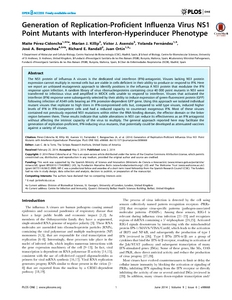Pérez-Cidoncha, M; Killip, MJ; Asensio, VJ; Fernández, Y; Bengoechea, JA; Randall, RE; Ortín, J
(2014)
Generation of Replication-Proficient Influenza Virus NS1 Point Mutants with Interferon-Hyperinducer Phenotype.
PLoS One, 9 (6).
e98668 (1) - e98668 (10).
ISSN 1932-6203
https://doi.org/10.1371/journal.pone.0098668
SGUL Authors: Perez Cidoncha, Maria Teresa
![[img]](https://openaccess.sgul.ac.uk/107045/1.hassmallThumbnailVersion/pone.0098668.pdf)  Preview |
|
["document_typename_application/pdf; charset=binary" not defined]
Published Version
Download (1MB)
| Preview
|
Abstract
The NS1 protein of influenza A viruses is the dedicated viral interferon (IFN)-antagonist. Viruses lacking NS1 protein expression cannot multiply in normal cells but are viable in cells deficient in their ability to produce or respond to IFN. Here we report an unbiased mutagenesis approach to identify positions in the influenza A NS1 protein that modulate the IFN response upon infection. A random library of virus ribonucleoproteins containing circa 40 000 point mutants in NS1 were transferred to infectious virus and amplified in MDCK cells unable to respond to interferon. Viruses that activated the interferon (IFN) response were subsequently selected by their ability to induce expression of green-fluorescent protein (GFP) following infection of A549 cells bearing an IFN promoter-dependent GFP gene. Using this approach we isolated individual mutant viruses that replicate to high titers in IFN-compromised cells but, compared to wild type viruses, induced higher levels of IFN in IFN-competent cells and had a reduced capacity to counteract exogenous IFN. Most of these viruses contained not previously reported NS1 mutations within either the RNA-binding domain, the effector domain or the linker region between them. These results indicate that subtle alterations in NS1 can reduce its effectiveness as an IFN antagonist without affecting the intrinsic capacity of the virus to multiply. The general approach reported here may facilitate the generation of replication-proficient, IFN-inducing virus mutants, that potentially could be developed as attenuated vaccines against a variety of viruses.
| Item Type: |
Article
|
| Additional Information: |
Copyright: 2014 Perez-Cidoncha et al. This is an open-access article distributed under the terms of the Creative Commons Attribution License, which permits
unrestricted use, distribution, and reproduction in any medium, provided the original author and source are credited. |
| Keywords: |
General Science & Technology, MD Multidisciplinary, MESSENGER-RNA TRANSLATION, VIRUS, INFECTED-CELLS, ANTIVIRAL RESPONSES, POLYMERASE COMPLEX, CELLULAR-PROTEIN, BINDING-SITE, IMMUNE-RESPONSES |
| SGUL Research Institute / Research Centre: |
Academic Structure > Infection and Immunity Research Institute (INII) |
| Journal or Publication Title: |
PLoS One |
| ISSN: |
1932-6203 |
| Related URLs: |
|
| Dates: |
|
| PubMed ID: |
24887174 |
| Web of Science ID: |
24887174 |
 |
Go to PubMed abstract |
| URI: |
https://openaccess.sgul.ac.uk/id/eprint/107045 |
| Publisher's version: |
https://doi.org/10.1371/journal.pone.0098668 |
Statistics
Item downloaded times since 21 Jul 2014.
Actions (login required)
 |
Edit Item |



